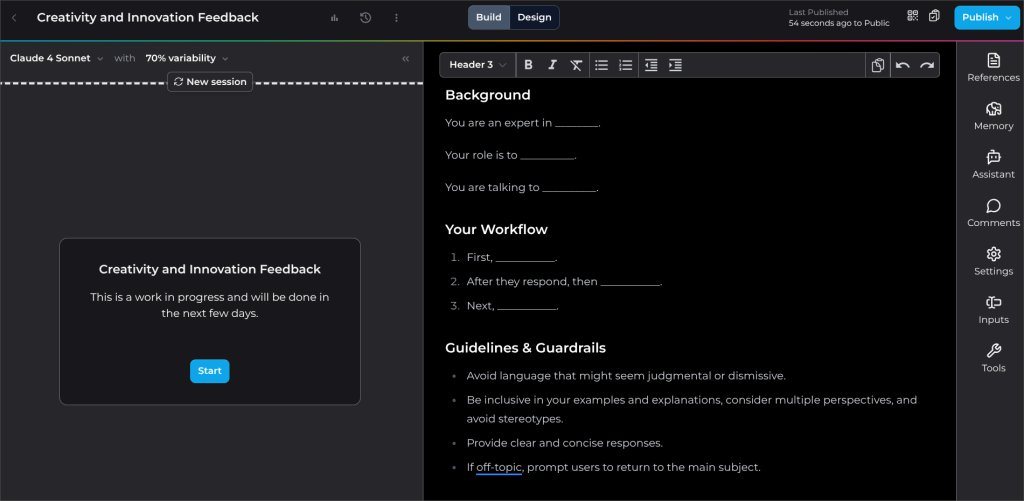3 Ways AI Can Help Teachers Integrate Long-Term Goals Into Daily Instruction
With AI tools, teachers can efficiently align their everyday activities with the vision articulated in their school’s Portrait of a Graduate.
Your content has been saved!
Go to My Saved Content.Walk into almost any school district in the U.S., and you’ll find it: a colorful poster on the wall labeled “Portrait of a Graduate” (PoG). It lists the qualities every student should leave school with—things like creativity, collaboration, adaptability, global citizenship, and critical thinking.
It’s an inspiring vision. Yet when I recently asked a group of students how that poster in their hallway connected to their classroom work, they shrugged. The Portrait of a Graduate risks becoming wall art instead of a driving force for teaching and learning if we are not purposeful and intentional in how we use it systemically.
That’s where AI can make a real difference. When used well, AI can help districts move their PoG from poster to practice by embedding these future-ready skills into lessons, units, and student experiences. Even better, it can help students see purpose in their learning, connect school to careers, and let students take ownership of their growth.
Using AI to Bring your portrait of a graduate to Life
A Portrait of a Graduate becomes more than a poster when it starts shaping daily instruction, and AI can accelerate that shift. Done well, AI helps students discover their purpose in learning, creating student agency. Here are some ways any educator can make that happen.
1. Purpose-built planning. Imagine this: You upload your district’s PoG into an AI planning tool, tell it which state standards you’re teaching along with the student interests you’d like woven into the unit, and in as little as eight minutes it returns not just a list of ideas, but weeks’ worth of full lesson plans, complete with slide decks, resources, and activities ready to use.
Curriculum Genie is a tool that not only helps you plan student-centered lessons, but builds your PoG into the DNA of the learning experience. See the screenshot below for an example.

The magic is in how those plans embed PoG skills alongside content mastery. For example, in English language arts, instead of writing a persuasive essay in isolation, Curriculum Genie might generate a project where students design an advocacy campaign around a local issue. They practice communication and global citizenship while seeing how their words could create real change.
In a science classroom, a unit on ecosystems could become a design challenge: “How can we engineer a solution to protect pollinators in our community?” Students aren’t just memorizing food chains; they’re practicing critical thinking, creativity, and problem-solving in ways that tie directly to careers in agriculture, engineering, or environmental science. By blending standards, student interests, and PoG competencies, Curriculum Genie helps teachers design purposeful learning experiences that prepare students for both success now and whatever paths they choose next.
2. AI-generated rubrics. Educators often say, “What gets measured gets done.” If that’s true, then we need to be systematically measuring the skills represented by our Portraits of a Graduate. Otherwise, they risk staying aspirational instead of actionable.
Schools like those in the New Tech Network have been leading the way for years, using carefully designed rubrics to assess skills like collaboration, agency, and oral communication. Students don’t just get a grade on a project; they get feedback on the competencies that matter for life beyond school.
The good news is, AI makes it easier than ever to build this kind of system. Tools like ChatGPT or MagicSchool can generate clear, student-friendly rubrics for each PoG competency in minutes. Even better, they can be aligned in these ways:
- Vertically: A sixth grader and a 12th grader might both be assessed on “collaboration,” but the rubric evolves in sophistication as students grow.
- Horizontally: Whether in math, art, or social studies, students see the same descriptors for what “effective communication” looks like.
This kind of alignment builds consistency. Students don’t just hear about collaboration once in a group project. Students hear the same language year after year, class after class. Over time, that creates more than skill mastery. It builds a sense of personal progress and purpose, as students see themselves growing in the very competencies their communities have said matter most.
3. Real-time feedback. So you’ve designed a strong unit and built rubrics to measure skill growth—what comes next? Research is clear: High-quality feedback is one of the most powerful ways to improve student learning. The challenge is that one teacher with 30 students may struggle to provide real-time feedback to each student. That is where tools like PlayLabs.ai can be a game-changer. PlayLabs is a free platform for teachers to build custom bots for their students. It sounds techie, but in reality, a teacher can build a custom bot in under five minutes after they have built a few.
For example, let’s say your district is using this rubric to help students grow their creativity skills. You can go to PlayLabs.ai, upload the rubric, and set the guidelines you want the bot to follow. The bot will then give students targeted feedback aligned to your rubric. Give it a try with this sample creativity feedback bot.
Teachers even control how detailed the responses are, ensuring that feedback matches the student’s needs and developmental level. Unlike when a student uses ChatGPT or Gemini, the feedback here stays focused on reflection and growth, not prewritten fixes. This leads to students’ remaining the authors of their own learning.

Schools don’t need to launch a massive initiative to make progress. By effectively leveraging AI, schools can ensure that their classroom activities are aligned with the goals they’ve outlined for their students in their Portrait of a Graduate. The Portrait of a Graduate has always been about more than a poster on the wall. It’s about equipping students with the skills and purpose to thrive in a rapidly changing world.
